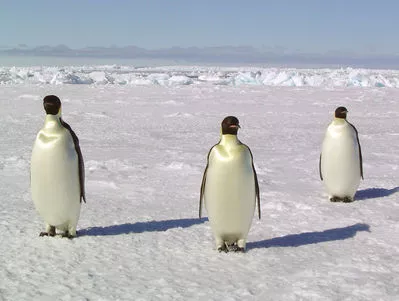If warming trends in global climate continue, thinning and shrinking Antarctic sea ice could push Emperor penguin populations toward extinction, says a study published today by the journal Global Change Biology. NSIDC scientists Mark Serreze and Julienne Stroeve contributed to the study, which was led by biologist Stephanie Jenouvrier of the Woods Hole Oceanographic Institution (WHOI).
The researchers studied a population of Emperor penguins at the coast of Terre Adélie in Antarctica. To project how penguin populations may fare in the future, the researchers used historical sea ice observations, future sea ice predictions from climate models, and a demographic model based on half a century's worth of observations on the penguins at Terre Adélie.
The study found that if temperatures continue to rise at their current rate—causing Antarctic sea ice to shrink—the penguin population of Terre Adélie could respond by declining toward extinction by the year 2100. "Our median projection shows a decline in the number of breeding pairs by 81 percent over this period, and a good chance (43 percent) of a more severe decline of 90 percent or more," the study says.
Sea ice, or frozen ocean water, plays an important role in global climate research as it reflects heat back into space and helps balance the heat circulating in the Earth's oceans and atmosphere. Much attention on sea ice has focused on the Arctic Ocean, because it has been declining rapidly in the last several decades. For this study, the researchers focused on the south polar sea ice. Stroeve says, “The Antarctic sea ice has been seeing a slightly positive trend for the last few years. But if the planet continues to warm, we may also have reductions in the Antarctic sea ice and that will surely affect the penguin population.”
Emperor penguins breed and raise their young almost exclusively on sea ice. If that ice breaks up and disappears early in the breeding season, massive breeding failure may occur, says Jenouvrier. “As it is, there's a huge mortality rate just at the breeding stages, because only 50 percent of chicks survive to the end of the breeding season, and then only half of those fledglings survive until the next year,” she says.
Also collaborating on the study were Marika Holland of the National Center for Atmospheric Research, Christophe Barbraud and Henri Weimerskirch of the Centre d'Etudes Biologiques de Chizé, and Hal Caswell of WHOI.
More Information
Media Contacts
WHOI Media Relations Office: media@whoi.edu or +1 508.289.3340
NSIDC Press Office: natasha.vizcarra@nsidc.org or +1 303.492.1497
